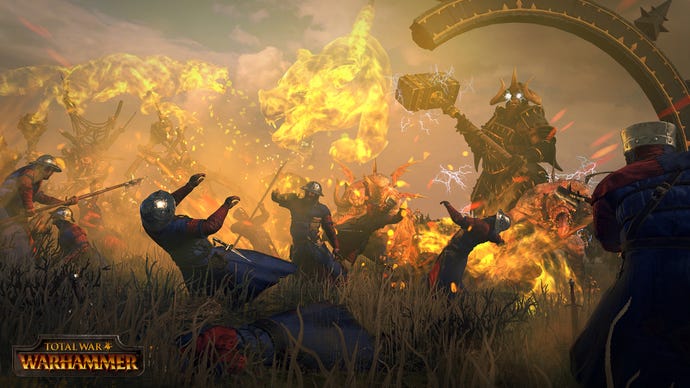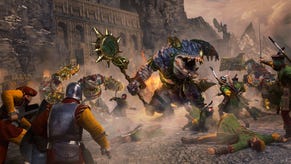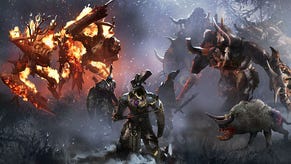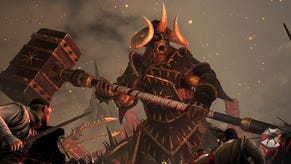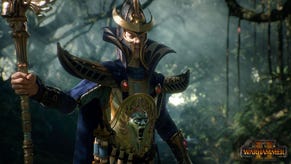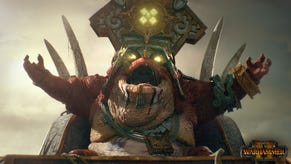Total War: Warhammer review - the most experimental Total War game in years
Total War's bizarro fantasy world refreshes the series, says Dan Griliopolous.
Total War: Warhammer review
I initially approached Total War: Warhammer with subtlety. My Vampire Count clan, starting in the troubled land of Sylvania, were exceptionally careful. Thankfully, the divided human lands of the Empire were riven with internecine struggles so were happy enough to see me wipe out my neighbouring vampire clans instead of attacking them. The neighbouring Dwarfs, in their mountain fastnesses, were equally happy to focus on exterminating the Orc threat.
We gradually expanded, only fighting when attacked, and bribing the human Empire and Dwarfs into almost being our friends. Meanwhile, we kept our armies only large enough to deter attack and used the money saved to build towering undead cities and pitchfork-proof vampiric castles. And when the world was focused on the North, defending against a mighty Chaos incursion, we raised armies of flying horrors and shambling legions and attacked from the rear...
Total War: Warhammer mingles the worlds of Games Workshop’s tabletop wargame Warhammer Fantasy Battle with Total War’s historical domination video game. It has substantial advantages over each. Compared to the former, you don’t have to spend hundreds of pounds on figures to play it (though you do need a £500 PC); compared to the latter, it introduces heavily asymmetric factions, flying units, giant monsters, and magic.
"Newcomers will struggle to understand what they should be doing, but will enjoy the spectacle anyway."
Playing the game, it’s very much grounded in old Total War. For the unfamiliar, these games work on two levels. First, there’s the turn-based campaign map. Here you upgrade settlements, conduct diplomacy, research new technology, and recruit and move your lords, units and heroes. It’s essentially a riff off Civilization.
Then comes the unique bit. When two hostile armies meet on the campaign map, you go to the battle level. This is a real-time 3D simulation of the map’s landscape, where you have fine control over the campaign armies’ formations, movements and special powers. Success, failure and deaths here feed back to the campaign level. In Total War: Warhammer, it’s not changed hugely from previous Total War games, and it works as well as it ever did - exciting and frustrating in equal measure. It’s always a thrill to pull off an against-the-odds victory.
We’ve played all of the included factions, though we’ve only played the Vampires to near-victory (which alone took us twenty-something hours - twice the time it would take you to complete Doom). The only faction we’ve not tried is Chaos, as it wasn’t included in our review code. From fighting them in game, we can see that they use a Horde mechanic, where they have no cities of their own but raze enemy settlements to generate income.
Of all the factions, The Empire is the one that’s most immediately familiar to veteran Total War players. It has an early modern / Medieval line-up of infantry, cavalry and cannons, as well as some powerful battle wizards. On the campaign, it behaves similarly to old Total War factions, conducting diplomacy with the many other human and Dwarf states. It’s probably also the faction best suited to beginners, given its easy starting position and friendly neighbours.
The Dwarfs, by contrast, are a little more complex. They have slow tough troops and no magic, so tend to sit in front of serried guns, crossbows and cannons and wait for the enemy to advance. They can only conquer former Dwarven territory, which mostly belongs to the Orcs & Goblins. On the campaign map they can travel underground, which allows them to bypass mountains and enemy armies. However, they’re also surrounded by enemies, including the Vampires and the particularly aggressive Orcs & Goblins, and will find it very hard to survive the early parts of the game.
"Giant creatures lack any micro abilities, so they’re uninteresting to control, even though they’re devastating to the enemy’s forces and look impressive."
The Orcs & Goblins have a wide array of cheap, cowardly infantry, cavalry and monsters. If you beat them in battle, it’s often because you made them run away. On the campaign map, they like to raid the human lands for loot but they can only conquer Dwarf cities. They have a special Waaagh! Mechanic, which means that if they keep winning fights then they grow stronger and spawn free supporting armies.
Finally, it’s arguable that the Vampire Counts are over-powerful. Not in combat, where their starting undead troops are exceptionally weak, but in the long game they have several huge advantages. Firstly, as they’re conquering territory, battles can involve huge casualties. These casualties stay as markers on the campaign map, allowing the necromancers to raise the battle’s dead quickly, in one go. That means a Vampire stronghold might look weakly defended, but a good local corpse pool might allow them to raise a huge top-tier army instantly and cheaply.
Secondly, though they don’t have ranged units, they have an array of flying units. From cheap Fell Bats to powerful Vargheists and Terrorgheists and even to the Zombie Dragon that the Legendary Lord Mannfred Von Carstein can be mounted upon. These make sieges quick and undermine any army that doesn’t defend its ranged units and artillery correctly.
Beyond each faction’s campaign behaviour and capabilities, the new elements taken from Warhammer make the strongest impact on the battle maps. Flying creatures are probably the biggest change, given their ability to bypass other units entirely and engage with each other in the air. They mean the stagnant Total War tactic of sitting your artillery and archers on top of a hill and surrounding them with spearmen is no longer viable. Given that some of the most powerful units in the game are flying - like the Terrorgheists - it’s a big change.
Heroes are another welcome addition. These include wizards, vampires, shamans, engineers, and so on. They take the place of the agents - like assassins - of earlier Total War games, and each hero type has a special ability they can perform on the campaign map, like increasing public order in a province. However, they can also be taken into battle, where they’re devastatingly-powerful, especially as they level up and acquire (the slightly disappointing) magic items.
Notably the Legendary Lords that head each faction introduce another big addition to the Warhammer world - narrative. They’ve each got three quest lines that take you through multiple missions, sending you all over the Old World, which result in a tough hand-crafted battle to win a unique magic item. These legendary lords are also the figures you negotiate with during the diplomacy, so their voice actors get multiple opportunities to overact delightfully. And it’s a welcome hard choice whether you send off your main general to tramp halfway round the map for a magic item when every turn could bring an invasion.
"It’s arguable that the Vampire Counts are over-powerful. Their starting undead troops are exceptionally weak, but in the long game they have several huge advantages."
Magic only works on the battle maps. Here coruscating artillery spells like the Wind of Death or Purple Sun of Xereus can wipe out big enemy formations and look stonking. Others retain the good looks, but produce minor statistical debuff effects that are quite disappointing. And I never quite got my head around the way the Winds of Magic worked in the game, meaning my fragile necromancers were often becalmed, unable to take part whilst the battle raged around them.
Other elements have less impact. Giant creatures are not totally new to the Total War world, given the elephants in Rome II, and they don’t behave hugely differently to their predecessors. Notably, they lack any micro abilities, so they’re uninteresting to control, even though they’re devastating to the enemy’s forces and look impressive.
Finally, several systems lack clarity. It’s almost impossible to tell what effect the Terror and Fear rules are having, without hunting for a tooltip. Each faction has a different style of tech tree, which is neat, but hunting out the effective upgrades amongst the mass of minor stat boosts is a challenge. Other elements - like trade or sieges - will be hugely off-putting to newcomers and remain obscure to veterans. For each faction there is a tutorial battle and an advisor who walks you through the first few turns, but it’s easy to accidentally skip the battle (which I did for two factions, without realising) and the advisor can’t cover all of the crazy detail you need to master the game.
All that said, this is the most bizarre, different and experimental that Total War has been since Napoleon, and the game is rewarding for that. Though it’s not quite at the level of Eve: Online or Crusader Kings 2, newcomers will struggle to understand what they should be doing, but will enjoy the spectacle anyway. Veterans, barring the inevitable grouches, will enjoy this more than they have in years.
